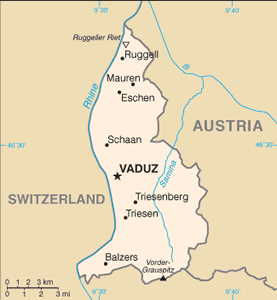The Geography of Liechtenstein
The Geography of Liechtenstein
Liechtenstein Geography
Location: Central Europe, between Austria and Switzerland
Geographic coordinates: 47 16 N, 9 32 E
Map references: Europe
Area: total: 160 sq km land: 160 sq km water: 0 sq km
Area - comparative: about 0.9 times the size of Washington, DC
Land boundaries: total: 76 km border countries: Austria 34.9 km, Switzerland 41.1 km
Coastline: 0 km (doubly landlocked)
Maritime claims: none (landlocked)
Climate: continental; cold, cloudy winters with frequent snow or rain; cool to moderately warm, cloudy, humid summers
Terrain: mostly mountainous (Alps) with Rhine Valley in western third
Elevation extremes: lowest point: Ruggeller Riet 430 m highest point: Vorder-Grauspitz 2,599 m
Natural resources: hydroelectric potential, arable land
Land use: arable land: 25% permanent crops: 0% other: 75% (2005)
Irrigated land: NA
Natural hazards: NA
Environment - current issues: NA
Environment - international agreements: party to: Air Pollution, Air Pollution-Nitrogen Oxides, Air Pollution-Persistent Organic Pollutants, Air Pollution-Sulfur 85, Air Pollution-Sulfur 94, Air Pollution-Volatile Organic Compounds, Biodiversity, Climate Change, Climate Change-Kyoto Protocol, Desertification, Endangered Species, Hazardous Wastes, Ozone Layer Protection, Wetlands signed, but not ratified: Law of the Sea
Geography - note: along with Uzbekistan, one of only two doubly landlocked countries in the world; variety of microclimatic variations based on elevation


